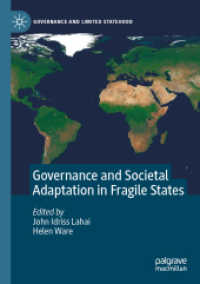- ホーム
- > 洋書
- > 英文書
- > Science / Mathematics
Full Description
An observational study infers the effects caused by a treatment, policy, program, intervention, or exposure in a context in which randomized experimentation is unethical or impractical. One task in an observational study is to adjust for visible pretreatment differences between the treated and control groups. Multivariate matching and weighting are two modern forms of adjustment. This handbook provides a comprehensive survey of the most recent methods of adjustment by matching, weighting, machine learning and their combinations. Three additional chapters introduce the steps from association to causation that follow after adjustments are complete.
When used alone, matching and weighting do not use outcome information, so they are part of the design of an observational study. When used in conjunction with models for the outcome, matching and weighting may enhance the robustness of model-based adjustments. The book is for researchers in medicine, economics, public health, psychology, epidemiology, public program evaluation, and statistics who examine evidence of the effects on human beings of treatments, policies or exposures.
Contents
Part 1: Conceptual issues 1. Overview of methods for adjustment and applications in the social and behavioral sciences: The role of study design 2. Propensity score 3. Generalization and Transportability Part 2: Matching 4. Optimization techniques in multivariate matching 5. Optimal Full matching 6. Fine balance and its variations in modern optimal matching 7. Matching with instrumental variables 8. Covariate Adjustment in Regression Discontinuity Designs 9. Risk Set Matching 10. Matching with Multilevel Data 11. Effect Modification in Observational Studies 12. Optimal Nonbipartite Matching 13. Matching Methods for Large Observational Studies Part 3: Weighting 14. Overlap Weighting 15. Covariate Balancing Propensity Score 16. Balancing Weights for Causal Inference 17. Assessing Principal Causal Effects Using Principal Score Methods 18. Incremental Causal Effects: An Introduction and Review 19. Weighting Estimators for Causal Mediation Part 4: Machine Learning Adjustments 20. Machine Learning for Causal Inference 21. Treatment Heterogeneity with Survival Outcomes 22. Why Machine Learning Cannot Ignore Maximum Likelihood Estimation 23. Bayesian Propensity Score methods and Related Approaches for Confounding Adjustment Part 5: Beyond Adjustments 24. How to Be a Good Critic of an Observational Study 25. Sensitivity Analysis 26. Evidence Factors








